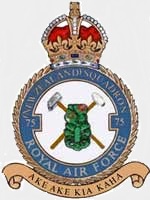Corgi AA34811 RNZAF Vickers Wellington Mk. IC Medium Bomber - R1162 / AA-Y, "Y for Yorker", No.75 (NZ) Squadron, RAF Feltwell, Norfolk, 1941 (1:72 Scale)
"Ake Ake Kia Kaha" ("For ever and ever be strong")
- Motto of No. 75 Squadron
 The twin-engine Wellington was the mainstay of Bomber Command until 1942, when the four-engine heavy bombers entered service. The Wellington prototype took to the air for the first time in June 1936 and production models entered service with the Royal Air Force in October 1938. By September 1939 Bomber Command had eight Wellington squadrons, which increased to 21 by the beginning of 1942. It was widely nicknamed the "Wimpey" after the character in the Popeye cartoon strip, J. Wellington Wimpey.
The twin-engine Wellington was the mainstay of Bomber Command until 1942, when the four-engine heavy bombers entered service. The Wellington prototype took to the air for the first time in June 1936 and production models entered service with the Royal Air Force in October 1938. By September 1939 Bomber Command had eight Wellington squadrons, which increased to 21 by the beginning of 1942. It was widely nicknamed the "Wimpey" after the character in the Popeye cartoon strip, J. Wellington Wimpey.
Wellingtons were the first bombers used to attack Germany in September 1939, but like all British bombers of the war they were lightly armed and suffered heavily from attacks by German fighters. In 1940 the Wellington squadrons were switched to night raids. The unique geodetic latticework construction of the Wellington made it particularly robust - able to sustain remarkable amounts of flak damage and yet still keep flying. The last Wellingtons were withdrawn from service over Germany and occupied Europe in 1943 but continued to serve in the Mediterranean theatre and over Burma until the end of the war. The Wellington proved a versatile aircraft and was also employed as a maritime patrol aircraft, a minelayer, and a transport. In all, 11,461 Wellingtons were built during the war, making it the numerous multi-engine aircraft produced by Britain.
Pictured here is a 1:72 scale replica of a RNZAF Vickers Wellington Mk. IC medium bomber known as "Y for Yorker", and was attached to No.75 (NZ) Squadron,then deployed to RAF Feltwell, Norfolk, during 1941.
Sold Out!
Dimensions:
Wingspan: 14-1/2-inches
Length: 10-1/4-inches
Release Date: June 2017
 Historical Account: "Kiwis" - The Wellington bomber proved to be an incredibly important aircraft in the history of the Royal New Zealand Air Force. Determined to modernize their force, they undertook a hugely expensive program to build three new airfields and equip them with modern aircraft - 30 Vickers Wellington Mk.IC bombers ordered in 1938. Crews would be sent to England for training, before flying their aircraft back to New Zealand and their newly constructed bases. As the crews neared the end of their training, it became clear that war in Europe was inevitable and the New Zealand government gifted the aircraft and their crews to the RAF, in order to help in the war effort. The New Zealand Squadron was renamed No.75(NZ) Squadron in early 1940, becoming the first RAF Commonwealth Squadron of the Second World War. It was unusual for Bomber Command aircraft to carry nose artwork, but the distinctive bomb dropping soda syphon carried by R1162 'Y for Yorker' has to be considered as among the most creative.
Historical Account: "Kiwis" - The Wellington bomber proved to be an incredibly important aircraft in the history of the Royal New Zealand Air Force. Determined to modernize their force, they undertook a hugely expensive program to build three new airfields and equip them with modern aircraft - 30 Vickers Wellington Mk.IC bombers ordered in 1938. Crews would be sent to England for training, before flying their aircraft back to New Zealand and their newly constructed bases. As the crews neared the end of their training, it became clear that war in Europe was inevitable and the New Zealand government gifted the aircraft and their crews to the RAF, in order to help in the war effort. The New Zealand Squadron was renamed No.75(NZ) Squadron in early 1940, becoming the first RAF Commonwealth Squadron of the Second World War. It was unusual for Bomber Command aircraft to carry nose artwork, but the distinctive bomb dropping soda syphon carried by R1162 'Y for Yorker' has to be considered as among the most creative.


